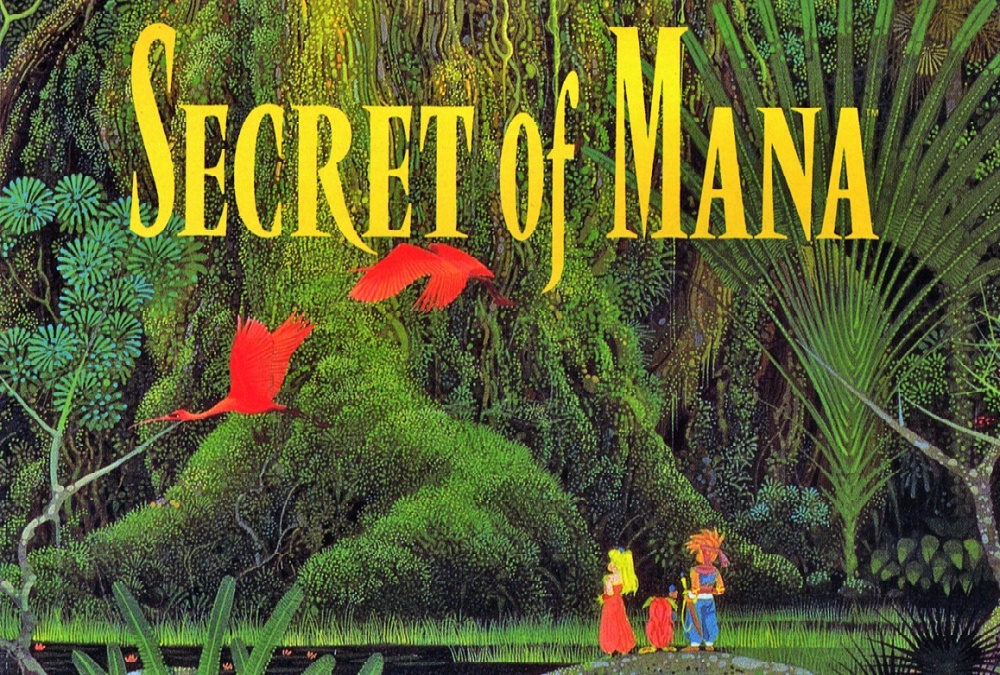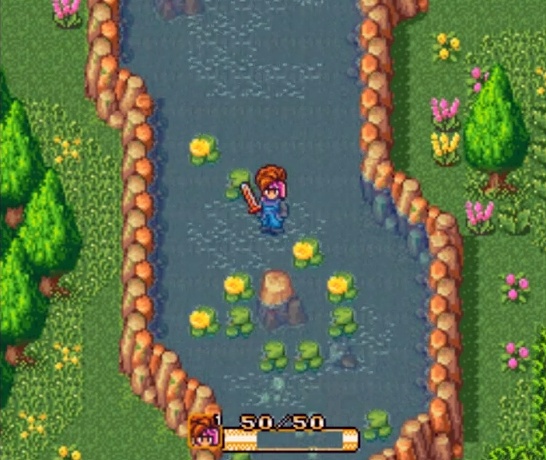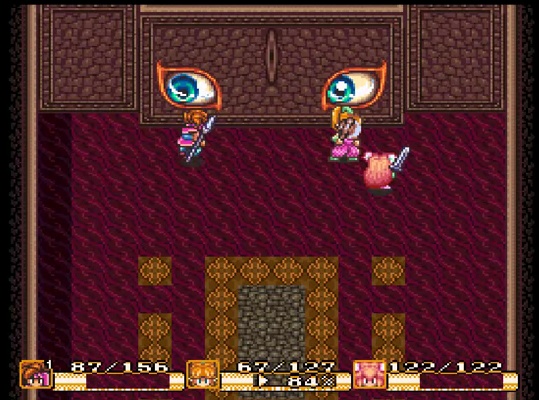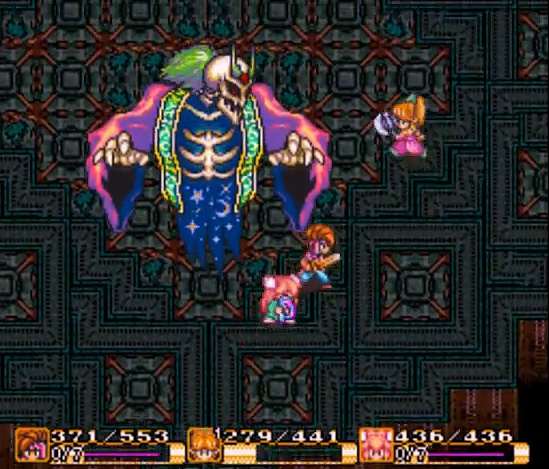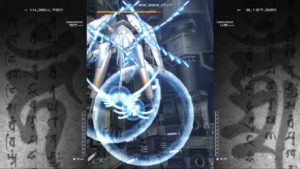“Walk the seasons from spring to winter,
spring again and we can enter…”
If The Legend of Zelda and Final Fantasy ever hooked up and got down to business, then Secret of Mana would be their extraordinary love child. Here was an RPG that looked gorgeous, sounded fantastic and once picked up, was hard to put down. Such was the quality of Secret of Mana that according to the 1990s Nintendo magazine SNES Force, people in Japan were apparently being mugged for it, while kids in America were skipping school to play it.
Produced by Square, Secret of Mana (Seiken Densetsu 2) was first released on the Super Nintendo in Japan on 6th August 1993. Twenty years on and the game is still fondly remembered.
The description on the back of the box paints a typical picture:
“There is one force in the universe that keeps good and evil in perfect balance. It is called the tree of Mana. But a magic sword has tricked a young warrior into upsetting this balance, spreading evil throughout the land. Thus, the warrior must undertake a dangerous journey to find the seeds of the Mana tree which have been hidden for centuries.”
This young warrior, the main character you control, is unaware that the Mana sword he has pulled from a stone has been protecting the land. With the sword now in his hand, monsters begin to appear all over. Restoring peace to the world means finding the eight seeds of the Mana tree, gaining their power and stopping a dark sorcerer from ruling the world. So far, so RPG. But Secret of Mana had a few tricks that still manage to astonish even today.
Secret of Mana was a follow-up to Legend of the Holy Sword (Seiken Densetsu), released on the Game Boy in Japan in 1991. Directed by Koichi Ishii (who had previously worked on Final Fantasy I – III), the game was a spin-off of the Final Fantasy series and was released across Europe in 1993 as Mystic Quest (it was also re-released under the name Final Fantasy Adventure in 1998). For an RPG it was notable for doing away with turn-based battles, instead implementing real-time combat, as well as introducing a power gauge that allowed the player to unleash a special attack. Both elements would find their way in Ishii’s Secret of Mana.
Development for Secret of Mana began on the proposed CD-ROM add-on for the Super Nintendo, with Nintendo having partnered with Sony to create the drive. However, following Nintendo and Sony’s infamous falling out over the project, the SNES CD-ROM was dropped. Ishii was suddenly faced with having to condense his expansive CD-based RPG onto a 16Mbit cartridge for the Super Nintendo.
According to Ishii, up to 40% of Secret of Mana’s original content was dropped so that it could be squeezed onto a SNES cartridge. The restructuring resulted in the removal of multiple storylines and alternate endings. Additional characters and locations were also scrapped. In the finished game there are a few villages and towns where you’ll come across empty rooms or can pass through the walls or walkways to areas that don’t really serve much purpose, coming across as remnants of a much larger game.
Square managed to release Secret of Mana in Japan on 6th August 1993, successfully selling over 1.5 million copies. For its US release, they were desperate to get it out there in time for Christmas. The English translation was put on the fast track and handled by Ted Woolsey. In an interview with Super Play magazine (ahead of the game’s UK release in 1994), Woolsey described the difficulty of translating Japanese games, highlighting the space limitations on a cartridge. “It’s just so tough squeezing the translated text into the game. What this means is that you have to rethink an entire plot without actually changing any of the parameters that govern how the plot has implications on the rest of the game…I would say that you can get twice as much information into the same space when written in Japanese as you can writing in English. But it’s the process of making sure that what you’re left with still makes complete sense, that’s the real time consuming problem.”
Woolsey revealed how excruciating this process was when given a strict deadline for translating Square’s game, saying, “I was given just 30 days to translate the Secret of Mana text. This meant that I had to fly out to Japan for a month with my wife and kids and just get on with translating the original scripts practically as soon as they were completed. There’s really no time to do justice to these games.” Woolsey revealed that while nothing was missing from the English version, some of the dialogue had been altered “for sake of space.” In a later interview with Hardcore Gaming 101 in August 2009, Woolsey described Secret of Mana as one of “the hardest” games he had to work on. “Things I translated often got ‘edited’ and when I read them the next day, I realized I needed to go back and change them again to make them grammatical. I loved that game, but am probably most dissatisfied with the final result. Certainly tried my best, but that thing nearly killed me.”
Woolsey met his deadline and the game did eventually hit the shelves in America in October 1993. It reached Europe around a year later in November 1994 to heaps of praise from the gaming press in the UK. Super Play magazine described how “the care and attention lavished upon the presentation alone sets it apart from anything you’ve seen before,” and rated it 94%. Edge awarded the game 9 out of 10, calling it, “in a class of its own as far as action RPGs or adventures are concerned.”
It was Secret of Mana that ‘properly’ introduced me to RPGs. My brother borrowed the game from a friend at school. Having never heard of it, and based on the limited description I was told, I didn’t really have high hopes. However, the magnitude of what you’re letting yourself in for begins before you even put the game in the console. Coming with a 68-page colour instruction manual, it explains that the game “may last nearly 70 hours.” The last 17-pages were a guide, taking the player through the first 2-3 hours. Also included was a map detailing key locations. After a few weeks of playing, we eventually bought it off the person who lent it to us. Our free time during weekends (and almost every evening after school) was spent delving further into the immersive story, levelling up the characters and simply wanting to know what would happen next.
As is often the case with RPGs, the player will find themselves controlling a group. You start the game as a young orphan Boy, but it’s not long before you’re joined by two others; a Girl searching for her boyfriend and a Sprite suffering from amnesia. While they do not have default names in the English version, the Japanese instruction manual names the Boy as Randi, the Girl as Purim and the Sprite as Popoi. With eight unique weapons that they can use, each character has their pros and cons. Randi is unable to cast magic but makes up for this with physical strength. Purim is well-balanced, able to cast healing and defensive magic to her fellow members. Popoi is physically the weakest but is capable of unleashing devastating attack magic.
Once the additional characters join you they are computer-controlled (from the menu, an action grid allows you to choose how aggressive or defensive they are). However, a multitap and two extra controllers means that two other players can join in. The three-player mode was groundbreaking for the time. During an interview with Ishii back when the game was released he revealed how Secret of Mana was originally intended to be a solo affair. “We thought a game like Gauntlet you can play noisily with friends would be fun,” he said. “So we tacked it [multiplayer mode] as a bonus.”
Adding the multiplayer element caused the game to be delayed in Japan due to numerous debugging problems, postponing its original release of April 1993 to August 1993. Even upon its release a few bugs still managed to make it through. In Japan Square issued a public statement informing players to not press any buttons when a boss is undergoing its death, as the game could freeze (bugs were lessened for the PAL release, but the game can still freeze should you press something during the death of the final boss).
Three-player Secret of Mana is a uniquely different experience. Suddenly it becomes a social RPG, making it a lot more fun and certainly more tactful, as you sit around the TV going through the story with others, shouting out helpful hints. These days, if you want to play an RPG with your best friend then, unfortunately, they can’t just pick up the controller and sit next you, they have to join in online (Final Fantasy Crystal Chronicles on the GameCube certainly tried to replicate the experience, but the difficulty came with each player requiring a Game Boy Advance and a link cable).
The game is full of little surprises. Be it frequently running into the Scorpion Army and their out of control robot, being picked up by a sandship during the first visit to the Kakkara desert, and Randi meeting his mother. There are also a lot of memorable boss battles, such as the Wall Face that pushes our heroes towards deadly spikes, and a defeated Frost Gigas that turns out to be Santa Claus!
The eight-channel stereo soundtrack composed by Hiroki Kikuta is incredible. With over 40 different compositions, the varied soundtrack changes to suit the location. The quality of tracks such as The Sorcerer/The Oracle when battling Thanatos (which is just pure evil), and Meridian Dance when facing the Mana Beast are enough to make you question just what the 16bit Super Nintendo was actually capable of.
With its roots as a CD-ROM game, the sheer look of Secret of Mana is amazing. Even today it still looks striking. The option to travel by cannon (quite early on in the game) skilfully showed off the console’s graphical Mode 7 effect. Essentially a taster when later you’re able to travel by riding the back of a dragon. It all looks very cool, as do the character animations when using powered-up weapons and casting magic (using magic spells past Level 8 would trigger unique animations). Even the animation when a character opens a treasure chest is pretty cute. On rare occasions some treasure chests dropped by enemies will contain armour you cannot buy anywhere, or even weapon orbs which you can use to strengthen your weapons (making it possible to forge a weapon passed the ‘supposed’ limit of Level 8 and up to Level 9). Sometimes treasure chests will sprout legs and attempt to run away from you, while as a twist some will even contain traps such as poison needles or bombs, inflicting damage.
Square did subsequently release Final Fantasy VI (titled III in the US) and Chrono Trigger for the Super Nintendo (two titles that unfortunately failed to see PAL releases). But it was Secret of Mana 2 (Seiken Densetsu 3) that caused the biggest upset, for the sequel didn’t even make it out of Japan. It’s believed that the length of the game (the player is able to choose three out of six characters, each with their own unique story arc) and masses of dialogue meant that an already bugged title would have to be reprogrammed in order to make room for an English translation, and at considerable time and cost too. Because of this, its western release was cancelled.
Nintendo’s mishandling during the development of Secret of Mana could also be seen by some as an early sign of the impending split between Square and Nintendo. With Square making the move to 3D visuals and FMV for their next-generation RPG, and Nintendo sticking with cartridges for the Nintendo 64, Square eventually developed Final Fantasy VII for the CD-ROM-based Sony PlayStation.
Even though Secret of Mana has been ported to the Wii Virtual Console and the iPhone, this has done nothing to diminish the value of the original Super Nintendo cartridge, which can still fetch high prices on eBay (a complete version of the game – be it PAL or US NTSC – can command in excess of £50).
Given the incredible quality of what players did receive, it does make one wonder just how amazing the experience could have been were Secret of Mana released as originally intended. Since then the Mana series has spawned many games, including Legend of Mana on the PlayStation, as well as Children of Mana and Heroes of Mana on the Nintendo DS. However, to this day, Secret of Mana has proven to be an influential classic, a true one-of-a-kind that no other sequel or spin-off has managed to surpass.
Originally published on MCM Buzz on 5 August 2013.
